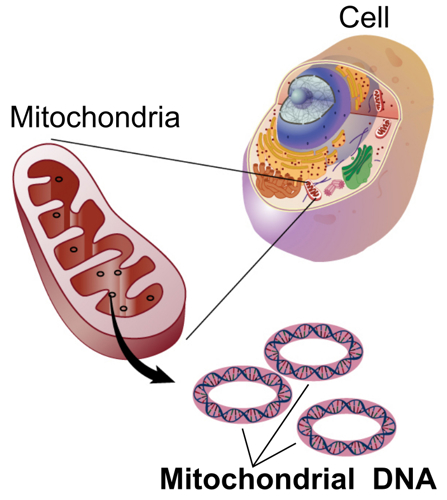
Is there a way to tell if someone is my half sister or full sister through 23andMe?
July 22, 2015

- Related Topics:
- Ancestry tests,
- Mitochondria,
- Chromosomes,
- Relatedness,
- Consumer genetic testing
A curious adult from California asks:
“I recently found someone who might be my half-sister through 23andMe testing. Is there any way to tell if we share the same mom or dad? (I am male.)”
Yes definitely. With a test like the one offered by 23andMe, there should be at least a couple of ways to tell.
The first is to look at those famous X and Y chromosomes. If the two of you are half brother and sister and share DNA on your X chromosome, then you have a common mom. And if you don’t share DNA there, odds are that you have a common dad.
The second way is to look at your mitochondrial DNA (mtDNA) results. This DNA is only passed from mother to child. So if the two of you have different mtDNA, then you probably don’t share the same mom.
Combining these two results should give you a pretty good idea of whether the two of you share a common mom or dad. That is, if you are half siblings.
Keep in mind that a half sibling looks an awful lot like a grandparent and grandchild or uncle/aunt and niece/nephew relationship at the DNA level. While age differences can usually rule out the first, there are plenty of aunts and uncles who are only a few years different in age from their nieces and nephews. So be careful in interpreting the results.
X Marks the Spot
As I said, one way you will know if you have a common mom or dad is by looking at the X and Y chromosomes. These are the chromosomes that determine if you will be biologically male or female. Most boys have an X and a Y chromosome, while most girls have two X’s.
When parents have kids, they each pass one of these chromosomes to their child. So moms always pass an X and dads pass either an X or a Y. If dad passes an X, the child will be biologically female and if he passes a Y the child will be biologically male.
You are biologically male, so you got your Y chromosome from your dad and your X from your mom. Your half-sister got one X from her mom and the other from her dad.
Here is a diagram of what this would look like if you have a common dad:


In this diagram, the shared dad has a black X and a black Y chromosome, mom 1 has two red X’s and mom 2 has two purple X’s.
As you can see, you have a red X and your half-sister got a purple one. The two of you don’t share any X DNA because your common dad gave you a Y and your half-sister an X. Your only X came from your unshared mom.
Here is what things look like with a common mom:


In this diagram, the shared mom has two red X chromosomes, dad 1 has a black X and a black Y chromosome, and dad 2 has a purple X and a purple Y chromosome.
In this case, the mom gives an X chromosome to each child. The half-brother will get his Y chromosome from his dad (Dad 1), the half–sister will get her other X chromosome from her dad (Dad 2). So, in this case, the half-siblings will share X chromosome DNA. They both have red X’s.
So if the two of you share X DNA, you almost certainly share the same mom. But it turns out that biology is a bit more complicated on the other side.
If the two of you do not share DNA on the X-chromosome, there is still a chance that you may share the same mom. Except for dad's X and Y, the two chromosomes in a pair get reshuffled as they are passed on to a child. This means that by chance the two of you may not have shared any DNA on your X even though you have the same mom!
Luckily, there is a second test to figure out if the two of you share moms or not. But before going into that, here is how you can see how much DNA the two of you share on your X chromosome:
- Hover over “Family and Friends” and click on “Family Traits”
- Type in the two people you want to compare and a diagram like this one should come up:


This is a half-brother and half-sister who share a common dad. Look at the very bottom and you will see the X (and the Y). Note there is no light blue on the X which indicates shared chromosomal DNA. So this man doesn’t share any X-chromosome DNA with his half-sister, indicating that they share a dad.
If they shared a mom, there would be light blue on the X-chromosome. Unless, by chance, they happened not to. Which gets us to the second test.
Mitochondria only from Mom
Another way to check if you share a mom is to look at your mitochondrial DNA (mtDNA). This works because mtDNA is passed only from mother to child. All of dad’s mtDNA is destroyed right after fertilization.
This type of DNA is found in an ancient structure in our cells, called the mitochondria, also referred to as the “powerhouse of the cell.” It has its own DNA that helps it to function, and all humans ONLY get mitochondria from moms! (Click here to learn why it probably has its own DNA.)


So, you can compare your mtDNA to your sister’s mtDNA and verify that you both share a mom. If you share a mom, you should have the same mtDNA. And if you don’t, then your mtDNA would be different.
Again this assumes the two of you are half siblings. People with closely related moms will also share the same mtDNA. So definitely keep that in mind!
Here is how you can compare your mtDNA in 23andMe:
1) Hover over My Results and click ‘maternal line.’ You should get something like this:


Note your subgroup (here it is H2A). Have your half-sister do the same and see if you match.

 Skip Navigation
Skip Navigation
